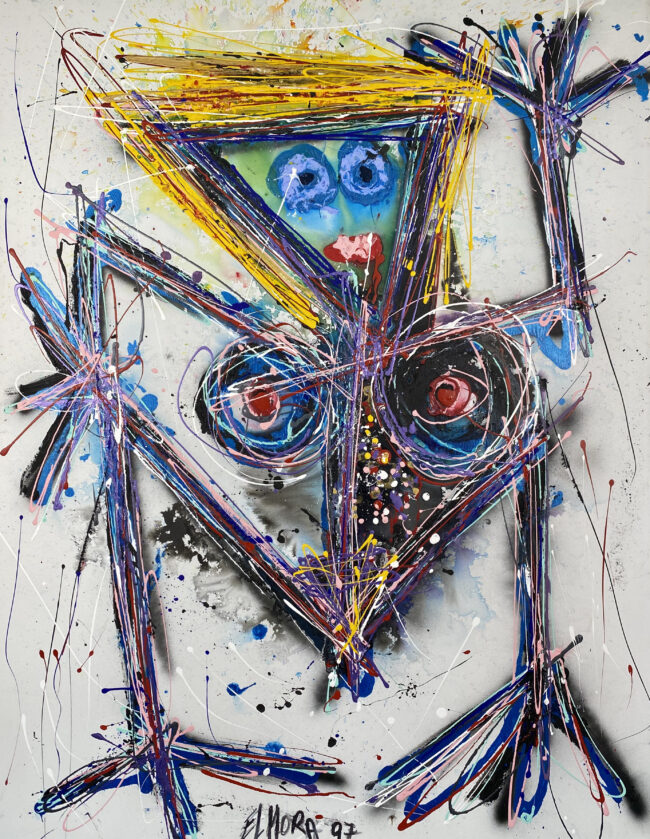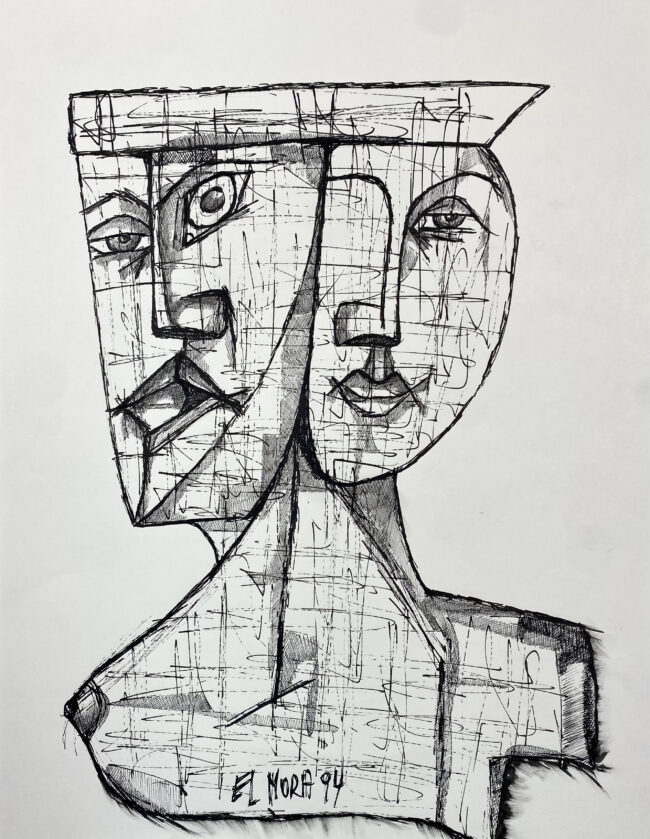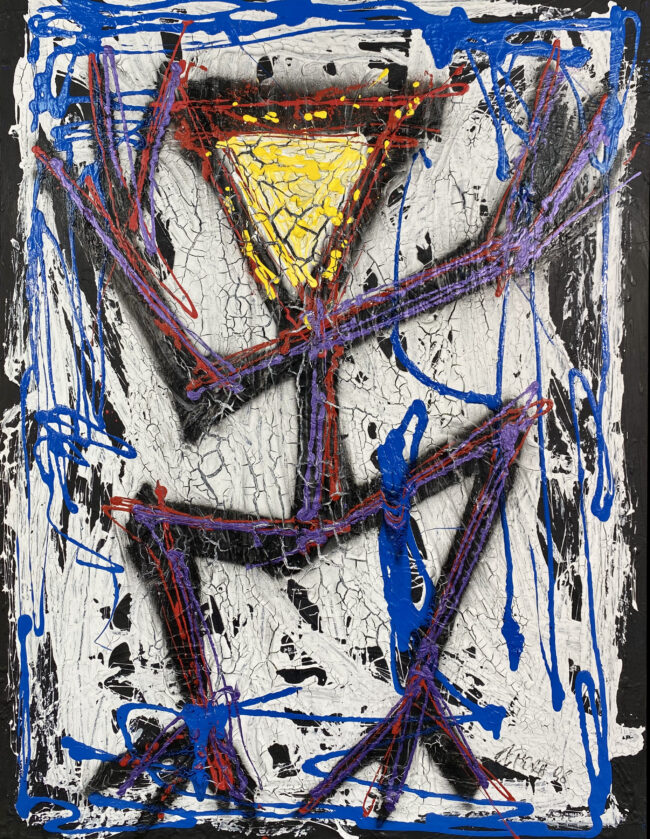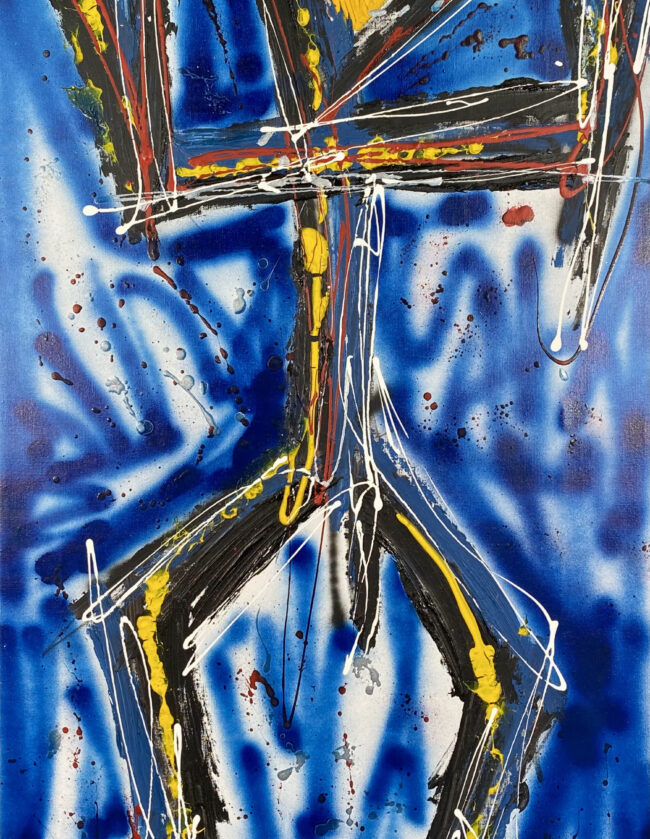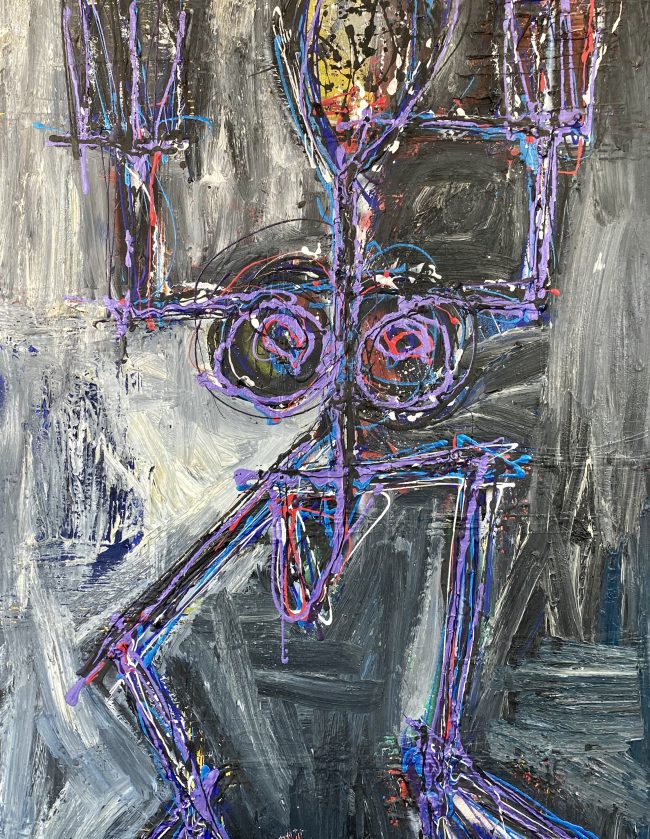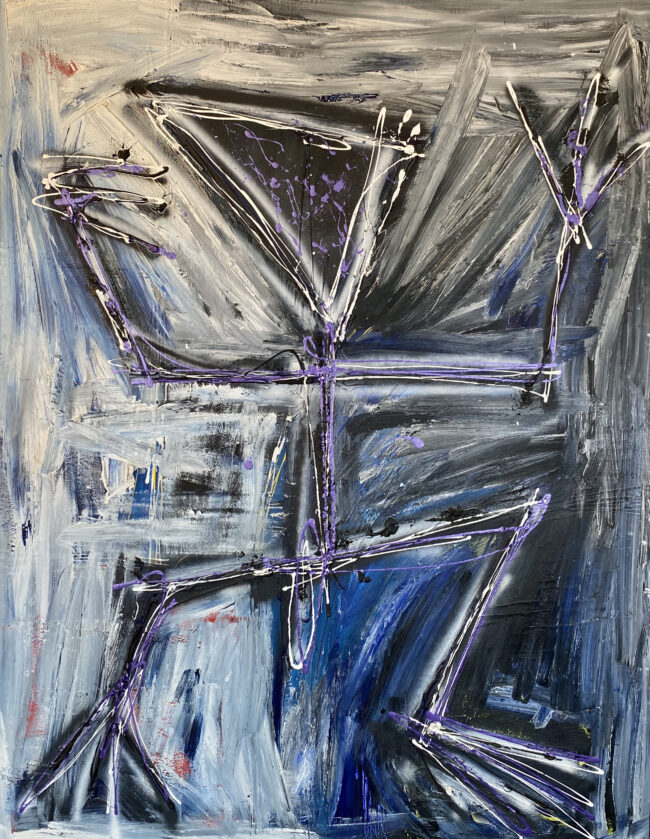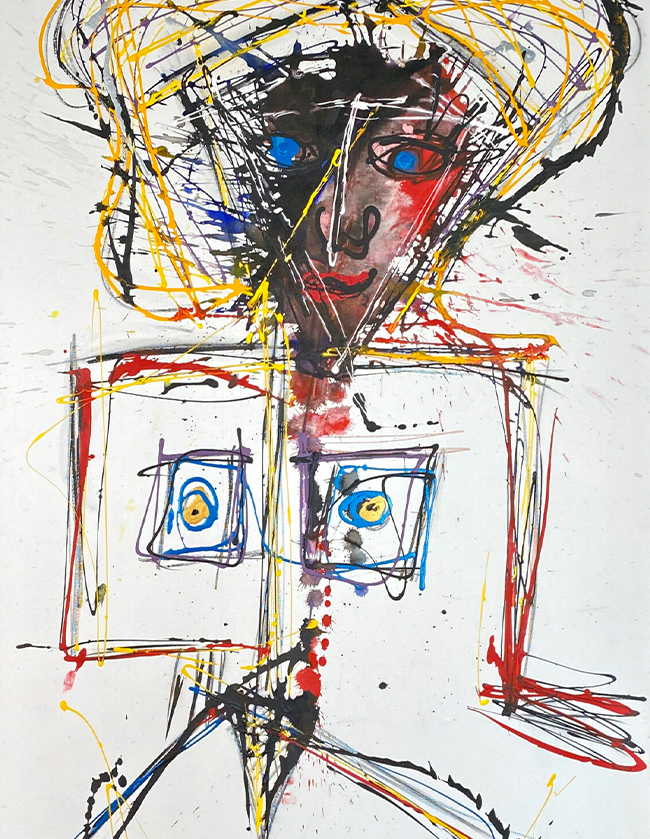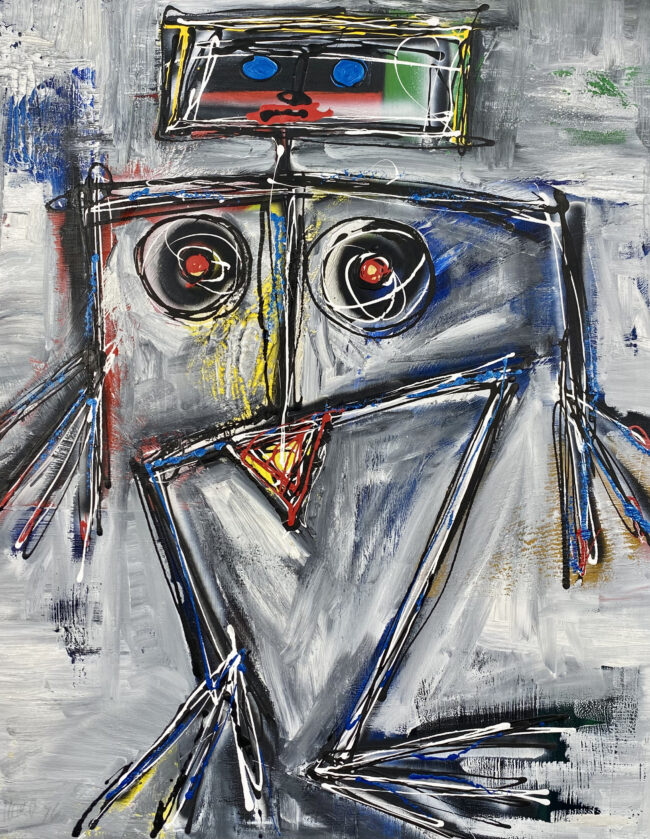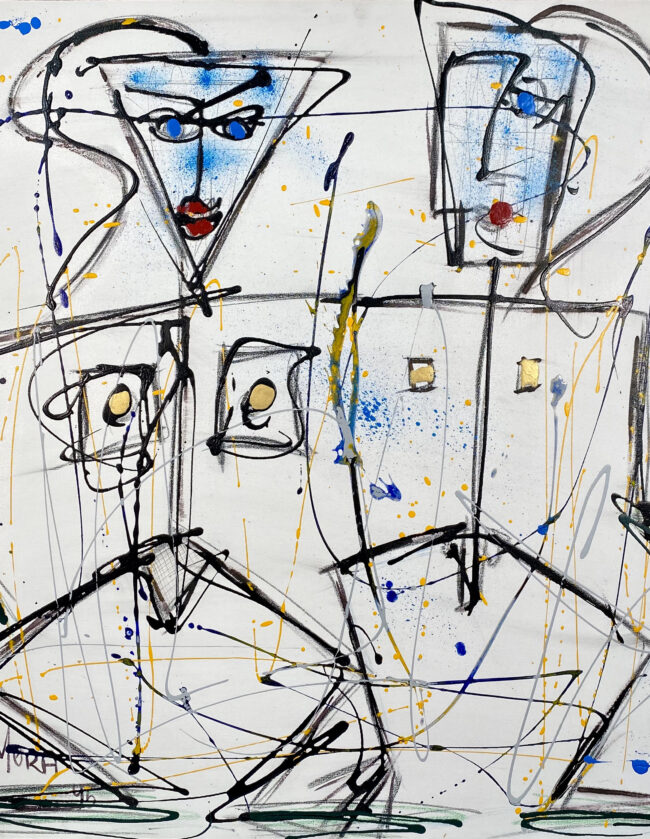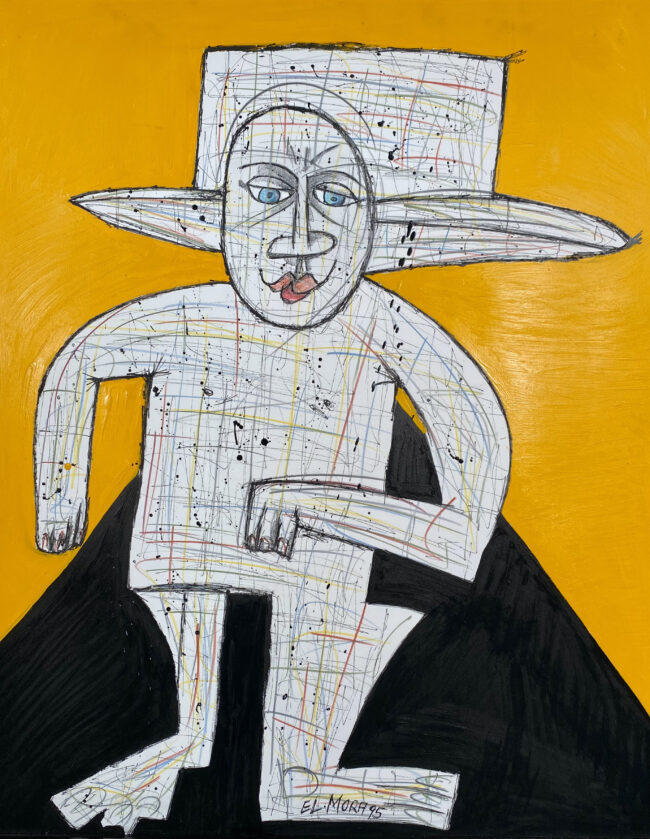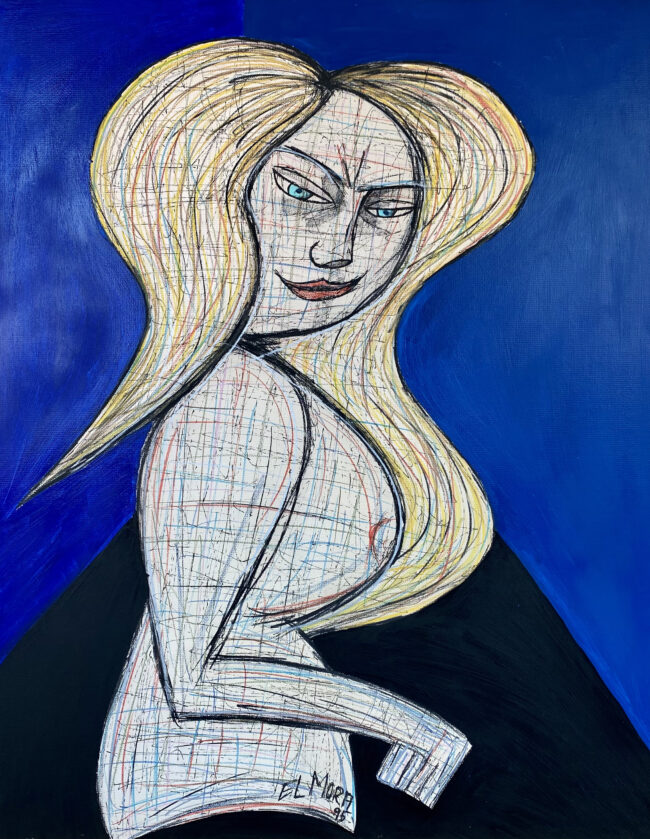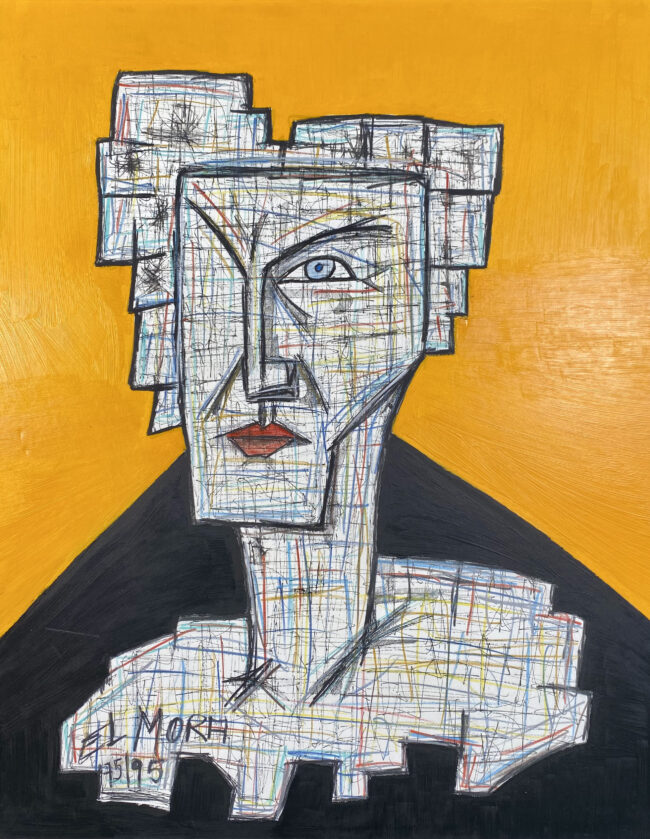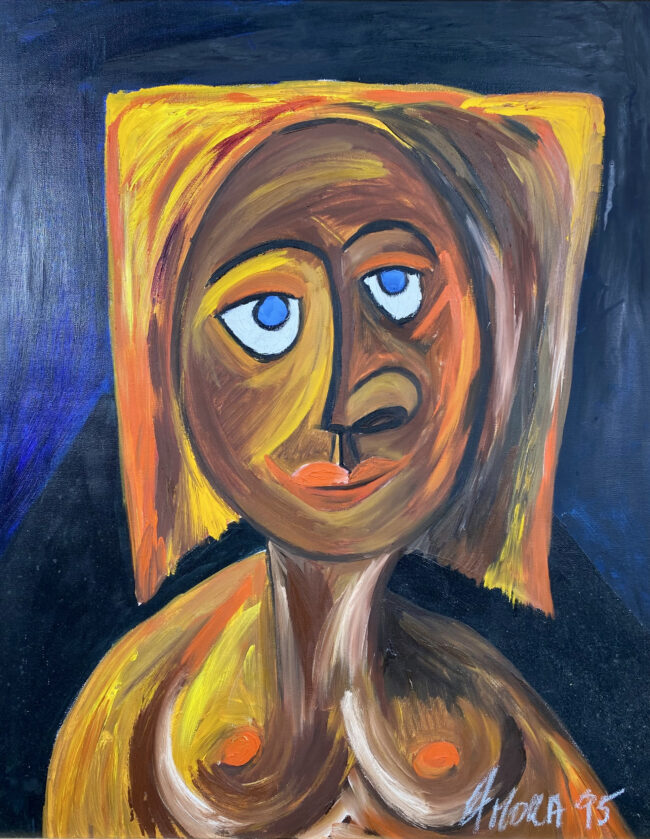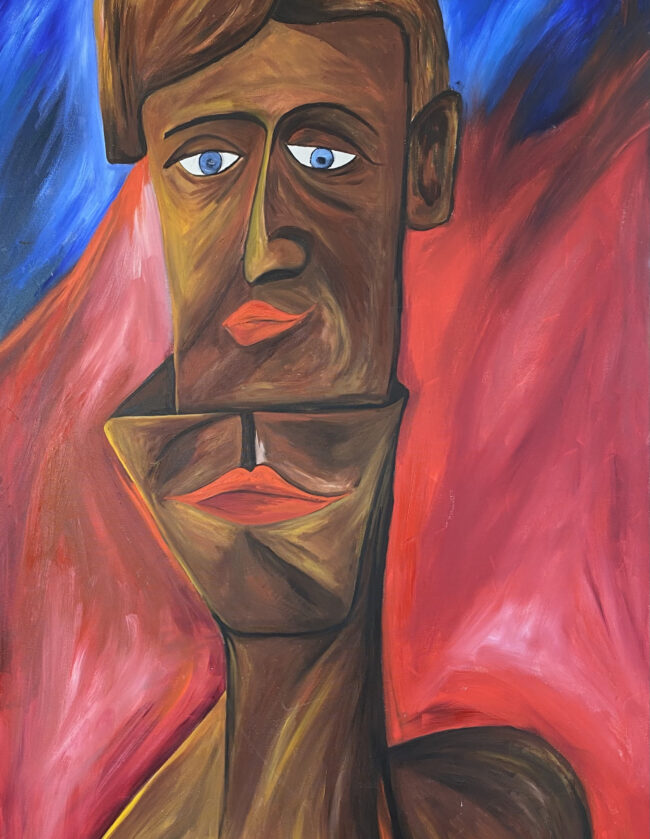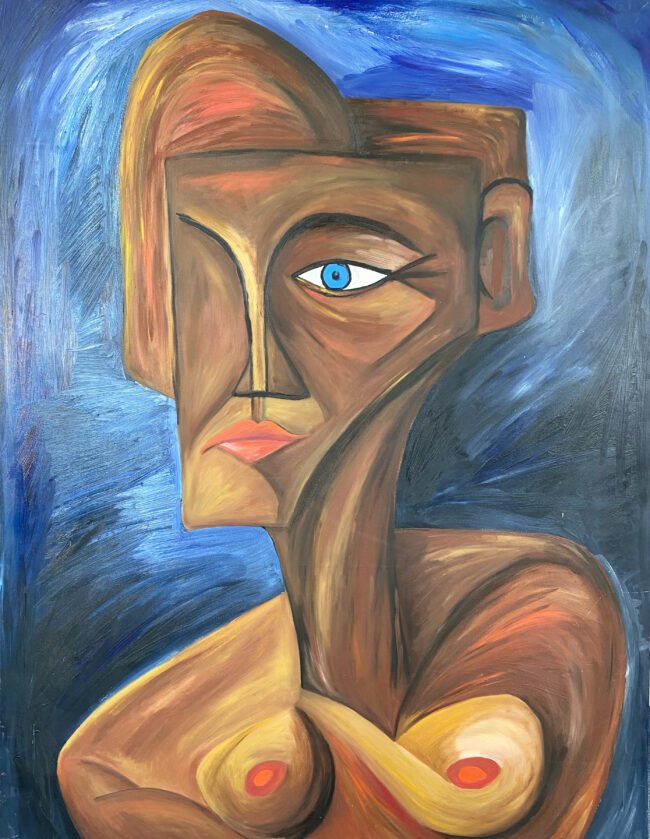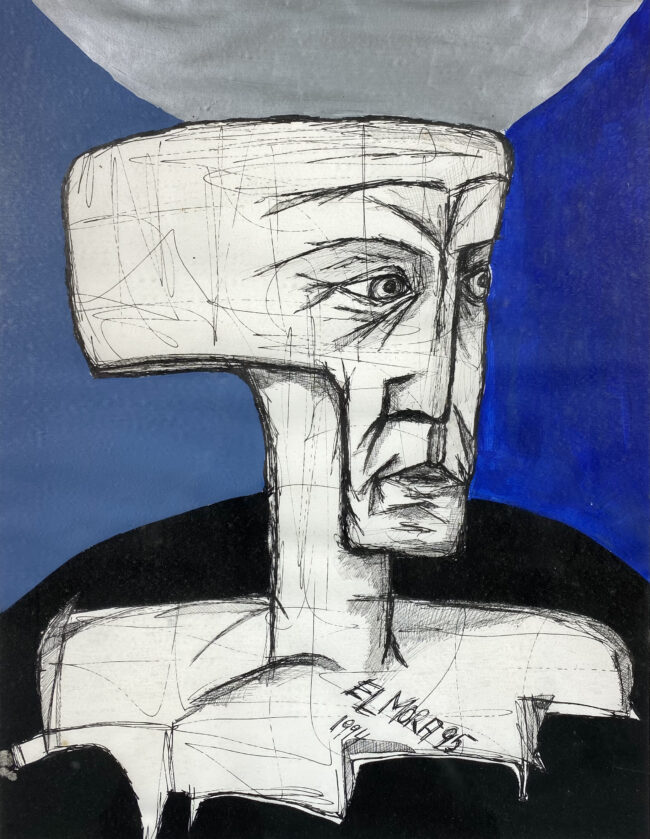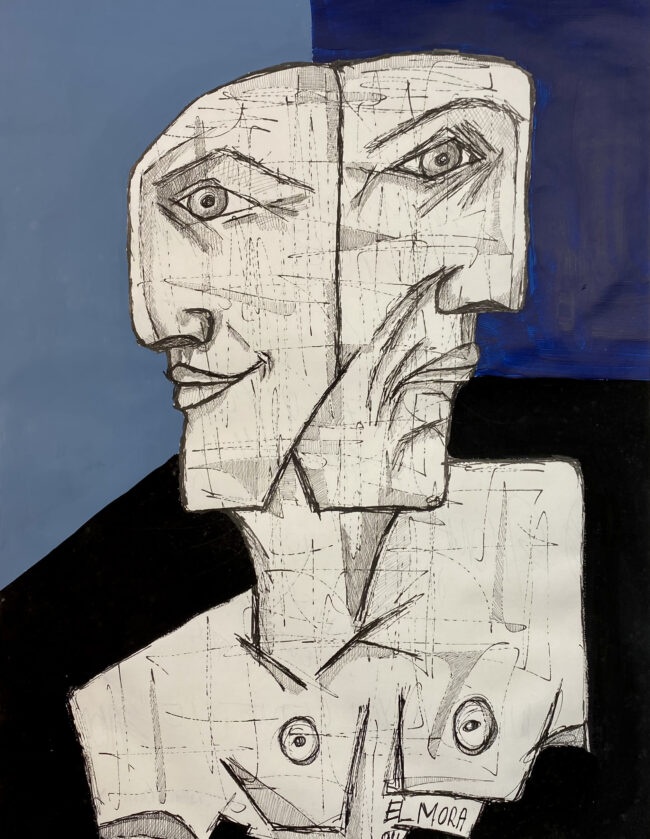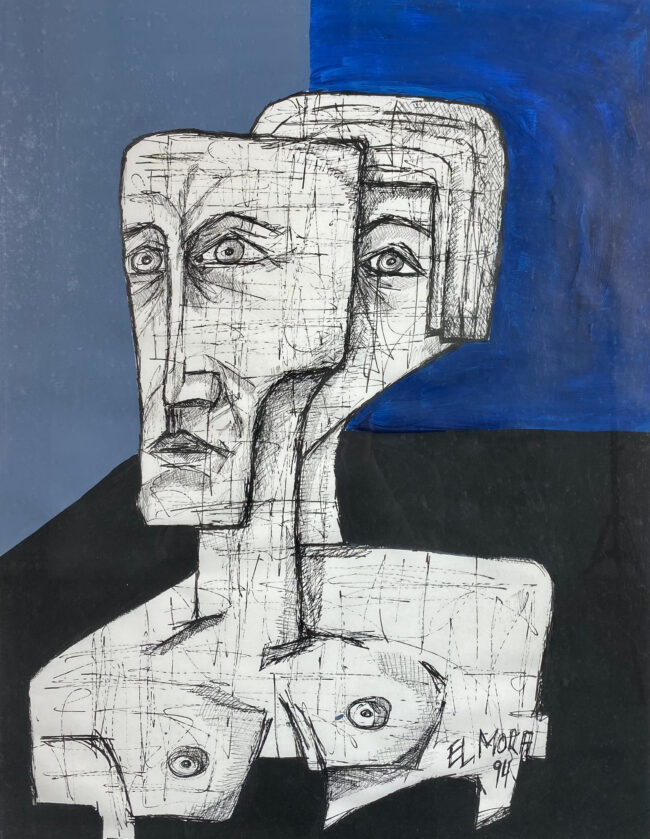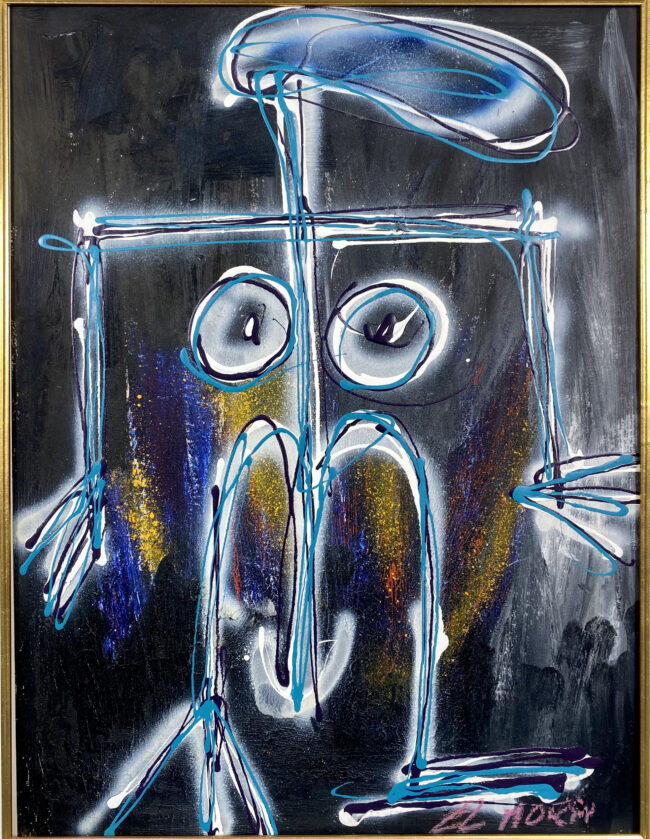Wild Thing, You Make My Heart Swing – Lost in Wilderness
Picture no./Bild Nr: 1997-011
Year/Jahr: 1997
Format: 80 cm / 156 cm
Technique/Technik: Acrylic on canvas
Read more
Some artworks speak through their mysteries and their untold stories. “Wild Thing” is one such piece, whose backstory I keep to myself. Thus, this painting remains a silent witness to my unspoken experiences and emotions. It connects my heart and my wildness in a way that is comprehensible only to me.
(Dr. Béla Vajay, Every painting is a confession, Bloomington, USA 2007 ISBN: 978-1-4259-5842-8 )
Der gesamte Hintergrund drückt die Bosheitsgefühle des Künstlers aus, einige schlechte Erinnerungen (schwarz), einige Erhabenheit (tiefes Violett) und eine gewisse Gelassenheit (tiefes Blau) beim Bemalen des Körpers dieser Frau. Ihr gelbes Haar muss ihn an ihre intellektuellen Qualitäten, ihre Sympathie und angeborene Zärtlichkeit (lachsrosa) erinnert haben. Der Rest von ihr ist weiß gestrichen, was auf Offenheit, Ausgeglichenheit und Reinheit hinweist. Nur ein paar schwarze Linien umranden ihre Körperteile. Ihre Brustwarzen und Genitalien sind leuchtend rot bemalt, was Vitalität und Bereitschaft zu erotischen Aktivitäten ausdrückt. Eine wesentliche Verherrlichung der „Frau“
The entire background is expressing the artist‘s feelings of malice, some bad memories (black) some grandeur (deep violet) and a degree of serenity (deep blue) while painting the body of this female. Her yellow hair must have reminded him of her intellectual qualities, her sympathy and innate tenderness (salmon pink) The rest of her is painted white, indicating openness, balance and purity. Only a few black lines delineating her body parts. Her nipples and genitalia are painted bright red, expressing vitality and readiness for erotic activities. An essential glorification of “woman”
Guess who is me
Picture no./Bild Nr: 1994-004
Year/Jahr: 1994
Format: 46 cm / 60 cm, PP 60 cm x 70 cm
Technique/Technik: ink drawing on Paper
Read more
In my days in America, specifically in my studio in Palm Beach, the piece “Guess Who is Me” was created. The double facial features mirror the duality of many people I met in Palm Beach. One face, meticulously curated for the outside world, and the other revealing the hidden, authentic essence. A scene of being, where the external presentation often masked the profound interior. It was a stage of life where not everything was as it seemed.
Enigma – I Love the Escape
Picture no./Bild Nr: 1998-001
Year/Jahr: 1998
Format: 76 cm / 102 cm Rahmen 90 cm / 117 cm
Technique/Technik: oil color, Acrylic on canvas
Read more
An artwork that journeyed through various phases of my life and creative processes. Starting as a landscape painting, reflecting the calm and naturalness of the 70s, it transformed in the years that followed. The head, which appeared in 1995, represented the internal search and transformation that I underwent in the 90s.
1996 brought “Enigma,” an expression of the puzzling and deep feelings that occupied me. Yet, this phase did not remain constant, and so the image was replaced by “Escape” in 1998. The experiences and pain I went through with the loss of Eptisam made it clear that I needed a fresh start and an escape from my previous life. “Escape” represents this desire for a new beginning and the flight from the shadows of the past. It stands for the urgent need to escape reality and venture a new start to find inner peace.
Tiny Dancer
Picture no./Bild Nr: 1997-006
Year/Jahr: 1997
Format: 58 cm / 128 cm Rahmen 77 cm x 144 cm
Technique/Technik: oil color, Acrylic on canvas
Read more
In the shadows of dimmed light and the sultry sounds of Tina Turner’s “Tiny Dancer,” I found myself enveloped in a scene of turmoil and concealed emotions. The dancer, albeit seemingly confident and unscathed in her performance, radiated a subtle vulnerability that inevitably captivated me as an artist. On my canvas, I sought to immortalize her duality of strength and fragility, her silent cry for visibility in a world that constantly overlooked her. Here, in color and form, her unspoken story found a place, an expression that transcended her physical portrayal and revealed the tender, torn heart of the “Tiny Dancer.”
No More I Love You – Oh Lucky Man
Picture no./Bild Nr: 1996-009
Year/Jahr: 1996
Format: 75 cm / 115 cm Rahmen 90 cm x 130 cm
Technique/Technik: Acrylic, oil color on canvas
Read more
After the final separation from Danielle, a sense of liberation permeated my work. Eptisam entered my life, igniting an intense, yet dangerous love. The painting blends joy from this new relationship and a premonition of the impending painful end. It poses the question of whether true happiness lies in new love while old wounds are still fresh.
(Dr. Béla Vajay, Every painting is a confession, Bloomington, USA 2007 ISBN: 978-1-4259-5842-8 )
Das Gemälde ist voller zerstörerischer Impulse – tiefes Deckrot gemischt mit Karmesingelb, einige violette Farben bedecken den Körper, einschließlich der Brüste, des Kopfes und der Genitalien. Hintergrund sind hier die großen Kommunikationsmedien. Am oberen Bildrand sind alle rachsüchtigen, dunklen Gedanken des Künstlers zu sehen – das Schwarz, das Grauschwarz, das Schmutzgrau und die weißlichen Grautöne. Unterhalb der rechten Brust und unterhalb ihrer Genitalien bedeutet die trübe weiße Farbe Eigenliebe, falsche Reinheit und Zerstörungswut, die nur eine Frau für einen Mann schaffen kann. Das untere Drittel dieses Gemäldes hat die gleiche Bedeutung wie das obere Drittel: „Frau, du bist gefährlich und du bist nichts für mich.“
The painting is full of destructive impulses – deep opaque-red mixed with crimson yellow, some violet colors covering the body, including the breasts, head and genitalia. Here the background is the major communication media. All of the artist’s revengeful, dark thoughts can be seen at the top of the painting – the black, gray black, the dirty gray and the whitish gray tones. Below the right breast and below her genitalia, the hazy white color signifies self-love, false purity and destructiveness, only a women can create for a man. The lower third of this painting has the same significance as the top third: “Woman , you are dangerous and you are not for me.”
No more I love you
Picture no./Bild Nr: 1996-007
Year/Jahr: 1996
Format: 107 cm / 140 cm Rahmen 125 cm x 155 cm
Technique/Technik: Acrylic, oil color on canvas
Read more
The flames of my love for Danielle had not yet been extinguished. Again and again, I found myself bound by the chains of this old love. I felt an urgent need to free myself from her, but that was easier said than done. Every attempt to detach myself from the memories and emotions seemed futile. The painting expresses this inner conflict and the desire for freedom from the burden of the past. It is a silent testimony to the battle between heart and mind.
(Dr. Béla Vajay, Every painting is a confession, Bloomington, USA 2007 ISBN: 978-1-4259-5842-8 )
Der Hintergrund ist in zwei Hälften geteilt. Auf der rechten Seite zeigen die weiß-blauen und roten Farben Gelassenheit, Unschuld, Erneuerung und vielleicht Erlösung an. Die andere Hälfte ist mit Dunkelblau bemalt, gemischt mit Hellblau, was blinden Glauben und Hingabe bedeutet. Die wesentliche Figur ist noch im Hintergrund eingebettet. Das Innere des Kopfes ist mit einer Mischung aus tiefviolett und dunkelblau bemalt, was bedeutet, dass dieser Kopf alle Geheimnisse, alle schmerzhaften Gefühle und alle zugefügten mentalen Schmerzen bewahrt. Von der rechten Seite kommt die Erlösung! Es ist das Geschenk der Reinheit, der spirituellen und emotionalen Absolution und des tiefen Glaubens an die Genesung von körperlichen und geistigen Schäden.
The background is divided into two halves. On the right, the white-blue and red colors indicate serenity, innocence, renewal and perhaps salvation. The other half is painted with dark blue, mixed with light blue, signifying blind faith and devotion. The essential figure is still embedded in the background. The interior of the head is painted a mixture of deep-purple and dark blue, signifying that this head is the keeper of all secrets, all painful emotions and all inflicted mental pain. From the right side comes the salvation! It is the gift of purity, spiritual and emotional absolution and the deep faith in recovery from physical and mental damages.
I Am So in Love
Picture no./Bild Nr: 1995-012
Year/Jahr: 1995
Format: 80 cm / 160 cm Rahmen 100 cm x 180 cm
Technique/Technik: Acryl on canvas
Read more
It was not my infatuation, but that of Angie from Palm Beach, which was directed at me. However, her love was too suffocating for me. I reflected this through a sporadic and emotionally charged image on the canvas.
Tanja also Scorpions Love to Dance
Picture no./Bild Nr: 1996-006
Year/Jahr: 1996
Format: 76 cm / 91 cm Rahmen 90 cm x 105 cm
Technique/Technik: Acrylic, oil color on canvas
Read more
The Scorpio zodiac sign symbolizes lived sexuality. Tanja, a fascinating Brazilian woman, spent every winter in Palm Beach. She had purchased the painting “Love Can Make You Dance.” However, as I was too attached to this work, it did not find its way into Tanja’s home in Sao Paulo. As an alternative, I painted this picture. For Tanja, however, it was not a substitute for “Love Can Make You Dance,” and so both paintings remain with me.
Love Can Make You Dance
Picture no./Bild Nr: 1995-011
Year/Jahr: 1995
Format: 91 cm / 91 cm Rahmen 105 cm x 105 cm
Read more
“Love is one of the most splendid experiences in life. It allows you to dance in both joy and pain alike. You might lose your rationality and potentially control over yourself. What an overwhelming feeling, what cruel pain! I have experienced deep pain, and through this experience, I have found my way.” Loving a person, an idea, or something else in your life can feel like this.
(psychologische Analyse des Bildes durch Dr. Béla Vajay, Every painting is a confession, Bloomington, USA 2007 ISBN: 978-1-4259-5842-8 )
Der weiße Hintergrund zeigt Gleichgewicht, Reinheit, Vollständigkeit und Spiritualität an. Der Kopf der Frau enthält blaue Flecken und große rote Lippen, die Hingabe und mündliche Sinnlichkeit ausstrahlen. Ihre Brüste und Genitalien sind fast farblos, was auf eine verminderte Libido hinweist. Der Kopf des Mannes ist rechteckig, mit einem Auge und wenigen blauen Flecken, die weniger Hingabe und weniger Loyalität verleihen. Beide Gesichter spiegeln Gelassenheit, Idealismus und kontrollierte Emotionen wider. Könnte dies die Liebe sein, die Dich tanzen lässt und die Schmerzen des Liebens erleben lässt?
The white background indicates balance, purity, completeness and spirituality. The woman’s head contains blue spots and large red lips, projecting devotion and oral sensuality. Her breasts and genitalia are nearly colorless, signifying reduced libido. The male`s head is rectangular, with one eye and few blue spots conferring less devotion and less loyalty. Both faces are reflecting serenity, idealism and controlled emotions. Could this be the love that makes you dance and experience the pains of loving.
The Hat is a Bit Too Big for Me, But I’ll Walk This Path
Picture no./Bild Nr: 1995-013
Year/Jahr: 1995
Format: 90 cm / 122 cm Rahmen 110 cm x 142 cm
Technique/Technik: ink, oil color pencil, Acrylic on cardboard
Read more
“Despite the budding confidence and looming success, I kept asking myself the question: Am I up to it? Large architectural projects lay ahead of me, including planning a magnificent castle with all the trimmings. I was both an artist and a businessman, but was that enough?
Doubts can often plague you, but sometimes decisions have to be made and the consequences bravely borne. The fear of possibly not being able to keep up is natural. However, true purpose and determination allow one to embrace every challenge. Even if the path is steep and the mountain high, it can be climbed with enough perseverance and conviction. And the elation of finally standing on the summit is priceless.”
Morton where is Merlin
Picture no./Bild Nr: 1995-019
Year/Jahr: 1995
Format: 80 cm / 100 cm Rahmen 90 cm x 110 cm
Technique/Technik: ink, oil color pencil, Acrylic on paper on cardboard
Read more
Morton, despite her youth, seemed to already embody all the characteristics of a gold digger from Palm Beach. “Where is Merlin?” was a playful wordplay for me. Merlin, the great wizard at King Arthur’s court, symbolized those in Palm Beach who pretended to a wealth that was nothing more than an illusion. Some Mortons fell for this magic, while others actually found their Sugar Daddy.
The Head – I know what I want I am happy
Picture no./Bild Nr: 1995-017
Year/Jahr: 1995
Format: 80 cm / 100 cm Rahmen 90 cm x 110 cm
Technique/Technik: ink, oil color pencil, Acrylic on cardboard
Read more
“The Old Head from 1973 Haunts Me Again
The old head from 1973 caught up with me again, yet now it was transformed – bright and friendly, with a firm and convinced facial expression of the new path. It was followed by the big breakthrough. This picture remains in my possession and has always found a place in my primary residence: first in Hobe Sound, then in the South of France, for two years in Kitzbühel, and finally in Monaco, only to now hang in my living room in Seekirchen. It will not be its last place. The image radiates all that has fulfilled my life.”
Danielle
Picture no./Bild Nr: 1995-037
Year/Jahr: 1995
Format: 40 cm / 60 cm
Technique/Technik: oil on canvas
Read more
Danielle, with her sorrowful gaze, reveals a painful void that had crept into her life. Our rekindled affair could not reignite the lost sparks, and we moved through a sea of past emotions that had lost their intensity. It was a relationship inhabited by the ghosts of the past and could no longer contain the fire that once burned. This could potentially serve as a powerful thematic representation for an artwork or a series, capturing the melancholy, the lingering, and perhaps the unfulfilled desires that haunted a relationship, unable to reclaim its former passion. The interplay of past and present emotions, memories, and unmet needs can create a poignant narrative that many might resonate with, reflecting universal themes of love, loss, and longing. This concept could be visualized in various expressive forms, such as painting, sculpture, or mixed-media art, exploring the emotional depth and complexity of human relationships.
The Mask
Picture no./Bild Nr: 1994-034
Year/Jahr: 1994
Format: 91 cm / 152 cm
Technique/Technik: oil on canvas
Read more
In “The Mask”, the multifaceted world of Palm Beach is vividly brought to life, serving as a reflection of the duality and hidden intentions I perceived in many of its inhabitants. In an environment where superficiality and facades often take precedence, my unfiltered honesty stood in stark contrast. The Swiss daily newspaper, Tages-Anzeiger, described me as a “rare creature. He says what he thinks, and this can sometimes be harsh, but it is true.” This mask symbolizes the constant struggle between the outward appearance and the true inner self, a portrayal of deceit which I often found hard to bear. However, this honesty and sober directness were highly valued by prominent individuals.
Grace Jones
Picture no./Bild Nr: 1994-033
Year/Jahr: 1994
Format: 91 cm / 107 cm
Technique/Technik: oil on canvas
Read more
In “Grace Jones”, the thematic continuation which originates in the head of 1973 is apparent. While the image shines in its autonomy, it carries within it the spirit of that preceding work, embodied in a new form and structure. Here, memories and the enduring influence of past artworks become visible, in an ongoing conversation through time, from image to image, each subtly yet persistently bearing the DNA of its predecessors. In this continuity, a timeless dialogue unfolds, woven through each subsequent artwork, always preserving an echo of the past in its present manifestation.
Loneliness where do I go 1995 I will know
Picture no./Bild Nr: 1994-018
Year/Jahr: 1994
Format: 46 cm / 60 cm, PP 60 cm x 74 cm
Technique/Technik: ink drawing, Acrylic on Paper
Read more
“Loneliness, Where Do I Go – 1995, I Will Know” reflects a critical phase of self-discovery and loneliness that I experienced after my Canadian girlfriend Danielle left. It symbolizes not only the painful absence of a loved one but also a longing for direction and purpose in my own life’s journey. A state of seeking, an inner journey, which found a turning point in 1995, as my path gradually emerged into the light.
(psychologische Analyse des Bildes durch Dr. Béla Vajay, Every painting is a confession, Bloomington, USA 2007 ISBN: 978-1-4259-5842-8 )
Eine dunkle mysteriöse, fast mythische Figur steht vor einem schwarz-blauen bis tiefblauen Hintergrund, der die Mystik betont. Das weiß-violette Gesicht und die obere Brust sprechen von einem offenen Geist, gemischt mit Angst, Leere und Verwirrung. Der verlängerte hintere Teil des Kopfes kann ein aufgeblasenes Ego oder vielleicht nur einen leeren Raum bedeuten. Das Gemälde ist von den Gedanken und Ängsten des Künstlers vor seiner eigenen Einsamkeit. Es ist die Furcht aller Propheten.
A dark mysterious, almost mythical figure is set against a black and blue to deep-blue background accentuating the mysticism. The whitish-violet face and upper chest are speaking of an open mind, mixed with fear, emptiness and confusion. The elongated back part of the head may signify an inflated ego or perhaps just an empty space. The painting is of the artist’s thoughts and fears of his own loneliness. It is the fear of all prophets.
Why Do You Leave Me? I Don’t Understand You
Picture no./Bild Nr: 1994-027
Year/Jahr: 1994
Format: 44 cm / 58 cm
Technique/Technik: ink drawing, Acrylic on Paper
Read more
This artwork embodies the tumult of an “on-and-off” relationship, permeated with love, passion, but also by a reality that inexorably drove us apart. Danielle and I were ensnared in a dance, shaped by her existing marriage, the children, and the ensuing obligations. Although a potent mutual attraction and infatuation bound us, my excessive artist’s life and my affairs created a distance that ultimately led to our final separation. This image is an expression of non-understanding, non-acceptance of this inevitable reality, and the painful gap between heart and mind.
(psychologische Analyse des Bildes durch Dr. Béla Vajay, Every painting is a confession, Bloomington, USA 2007 ISBN: 978-1-4259-5842-8 )
Zwei Drittel des Hintergrunds sind schwarz, was auf Trübsinn, Bosheit, Groll und kontrollierte Wut hinweist. Das andere Drittel ist tiefblau bemalt und verkündet Loyalität, Aufrichtigkeit, Glauben und Hingabe. Die beiden Profile haben einige Ähnlichkeiten und einige Optionen: Das jüngere Profil taucht aus dem tiefblauen Hintergrund mit einer kleinen, schrägen Schulter auf, was Unbereitschaft, aber genug Arroganz widerspiegelt, um sich beiden zu stellen, dem Selbst und dem Ordnungsselbst. Das Profil des älteren Mannes scheint aus seinem trostlosen schwarzen Hintergrund herauszutreten und zeigt Bitterkeit, Groll und dunkle Entschlossenheit. An dieser Stelle zeigt uns EL MORA sein Urteil: Beide Gesichter sind grauweiß bemalt, was auf eine antagonistische und starke spirituelle Verbundenheit hinweist, aber auf eine unterschiedliche Denkweise.
Two thirds of the background is black, indicating gloom, malice, resentment, and controlled anger. The other third is painted deep blue, proclaiming loyalty, sincerity, faith, and devotion. The two profiles have some similarities and some options: the younger profile is emerging from the deep blue background with small, slanted shoulder, reflecting un-readiness, but enough arrogance to face both., the self and the order-self. The profile of the older man seems to be stepping out from his bleak black background, showing bitterness, resentment and dark determination. At this point EL MORA is showing us his judgement: both faces are painted grayish white, indicating antagonistic and strong spiritual connectedness, but of different mindset.
Stand behind me
Picture no./Bild Nr: 1994-026
Year/Jahr: 1994
Format: 44 cm / 58 cm
Technique/Technik: ink drawing, Acrylic on Paper
Read more
“Stand Behind Me” serves as an emotional plea, interwoven with my longing for Danielle. This piece communicates a profound need for her love, support, and the desire not to confront the numerous challenges of that life phase alone. It was a time characterized by intense creativity in my painting, a phase where I was as inspired as rarely before. Simultaneously, this period also marked a peak in my creative entrepreneurial endeavors and in architecture. The days were full, and often the hours seemed to fly by, leaving little time to pursue all my passions. More than ever, I needed Danielle’s strength and support in those moments.
(psychologische Analyse des Bildes durch Dr. Béla Vajay, Every painting is a confession, Bloomington, USA 2007 ISBN: 978-1-4259-5842-8 )
Das lange, benommene männliche Gesicht und das teilweise verborgene weibliche Gesicht sind mit einer Mischung aus sehr hellen violetten und weißen Farben bemalt, was darauf hindeutet, dass beide Bilder über eine hohe spirituelle Stärke verfügen – beide Gesichter sind von hellen und dunklen schwarzen Linien gezeichnet, die unregelmäßigen Quadraten ähneln Zeichen vergangener Not. Die tiefblauen und schwarzen Hintergründe erzählen auch von einer dunklen, geheimnisvollen Vergangenheit und dem Kampf mit Depressionen oder Unsicherheit. Dies ist ein großartiges Charaktergemälde. Hier spricht der Künstler durch die Verwendung von Formen und Farben offen zu uns
The long, dazed male face and the partially hidden female face are painted with a mixture of very light violet and white colors, indicating that both images posses’ high spiritual strength – both faces are scarred by light and dark black lines resembling irregular squares as the sign of past hardship. The deep blue and black backgrounds is also telling of dark, secretive past and struggles with depression or uncertainty. This is a great character painting. Here the artist is openly speaking to us by the use of shapes and colors
Dance with Me, Woman in Red
Picture no./Bild Nr: 1997-002
Year/Jahr: 1997
Format: 45 cm / 60 cm Rahmen 66 cm x 80 cm
Technique/Technik: Acrylic, oil color on paper on cardboard
Read more
Even though this painting doesn’t feature red color elements, the title “Woman in Red” stands metaphorically for fire and danger, which are often associated with the color red. The work, which is part of the Eptisam series, depicts an unusual head shape, straying from my typical angular or rounded representations. The different shape and the implicit red embody the complexity, passion, and inherent risk that was palpable in my relationship with Eptisam.
